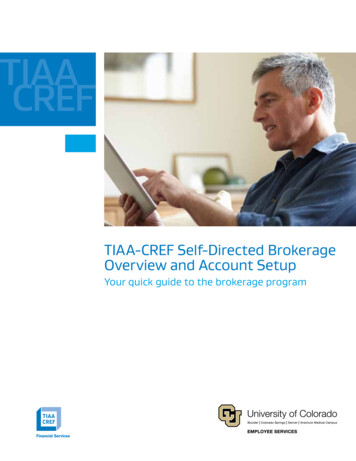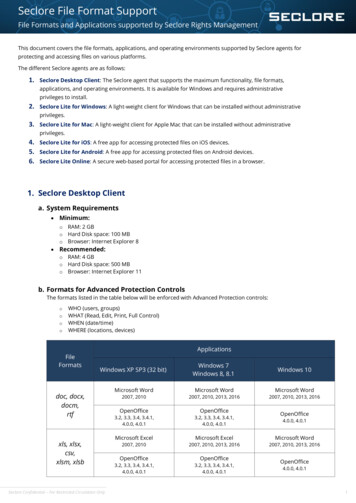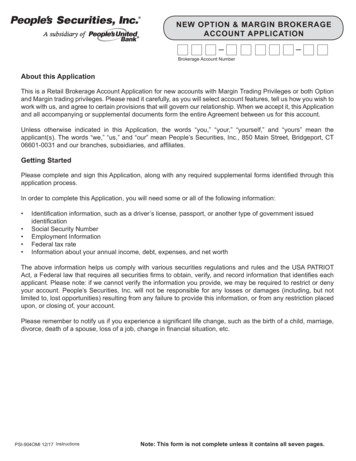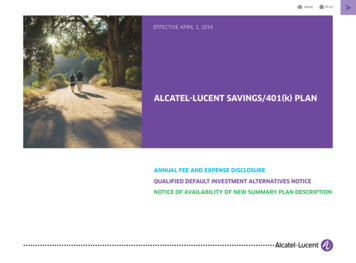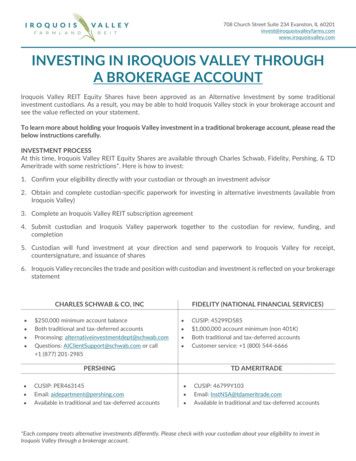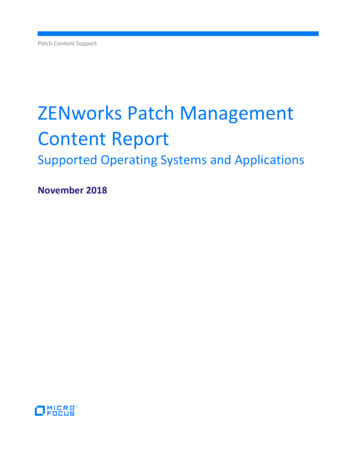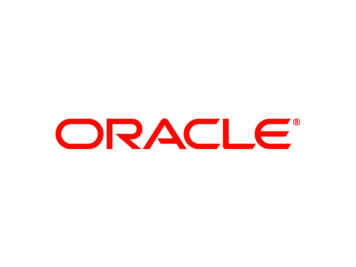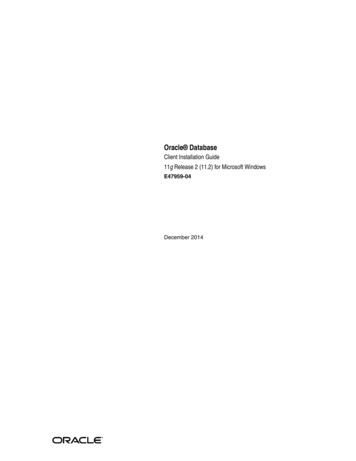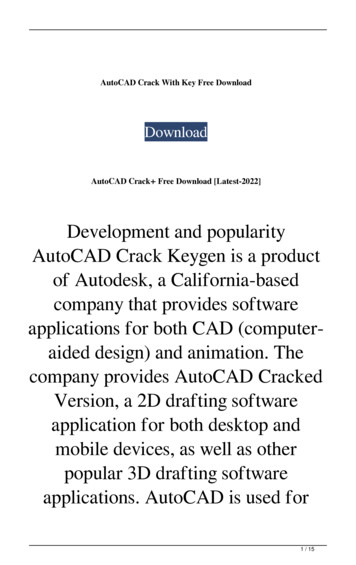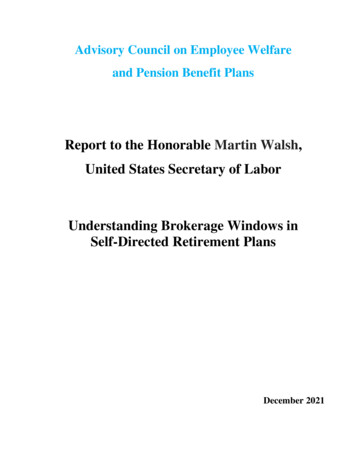
Transcription
Advisory Council on Employee Welfareand Pension Benefit PlansReport to the Honorable Martin Walsh,United States Secretary of LaborUnderstanding Brokerage Windows inSelf-Directed Retirement PlansDecember 2021
NOTICEThis report was produced by the Advisory Council on Employee Welfare and Pension Benefit Plans,usually referred to as the ERISA Advisory Council (the “Council”). The Council was established underSection 512 of the Employee Retirement Income Security Act of 1974, as amended (“ERISA”) to advisethe Secretary of Labor (the “Secretary”) on matters related to welfare and pension benefit plans. Thisreport examines brokerage windows in self-directed individual account retirement plans that are coveredby ERISA with the goal of gaining a better understanding of their prevalence, usage, andimplementation.The contents of this report do not represent the position of the Secretary or of the Department of Labor(the “Department”).-2-
LIST OF COUNCIL MEMBERSGlenn E. Butash, Council ChairJames G. Haubrock, Council Vice ChairWilliam B. Johnsen, Issue ChairTearyn J. Loving, Issue Vice ChairDave Gray, Drafting Team MemberEdward A. Schwartz, Drafting Team MemberMarcy L. Supovitz, Drafting Team MemberPeter J. Wiedenbeck, Drafting Team MemberMegan BroderickJulie A. CurtisJohn R. HarneyMercedes D. IkardAnthony Marc PerroneAndrea T. Sellars-3-
ABSTRACTThe 2021 ERISA Advisory Council examined brokerage windows in participant-directed individualaccount retirement plans that are covered by ERISA. The purpose of the examination was to gain abetter understanding of their prevalence, usage, and implementation. The examination focused on:(1) the prevalence of brokerage windows (the number of plans that have them and the extent to whichassets are invested in them); (2) which types of plans have brokerage windows; and (3) which planparticipants use brokerage windows and in what manner.In 2012, the Department issued a revised Field Assistance Bulletin that clarified: (1) what informationrelated to a brokerage window needs to be disclosed under the participant-level disclosure regulation;and (2) that a brokerage window is not in and of itself a designated investment alternative. Apart fromthe specific requirements of the participant-level disclosure regulation, the guidance did not deal withERISA’s fiduciary standards, and there is no additional Department guidance on this issue. To increasethe Department’s understanding of the prevalence and role of brokerage windows in participant-directedindividual account plans, the Department issued a Request for Information (“RFI”) in 2014. The RFIfocused on why and how often brokerage windows are offered and used in ERISA-covered plans. TheDepartment was interested in whether additional guidance would be appropriate and necessary to ensurethat participants and beneficiaries with access to a brokerage window are adequately protected underERISA. The work of the Council was intended to assist the Department to achieve its goal as stated inthe RFI.-4-
ACKNOWLEDGEMENTSThe Council recognizes the following individuals and organizations who provided testimony orinformation that assisted the Council in its deliberations and the preparation of its report.Notwithstanding their contributions, any errors in the report rest with the Council alone.Bruce Ashton, Faegre Drinker Biddle & Reath LLPJordan Backman, Sony Corporation of AmericaLisa Bleier, SIFMAAlison Borland, Alight SolutionsAngela Capek, Fidelity InvestmentsShannon Edwards, TriStar Pension ConsultingDiann Howland, American Benefits CouncilKathleen Kelly, Compass Financial PartnersPhyllis Klein, CAPTRUSTMichael Kreps, Groom Law Group, CharteredKevin Mahoney, FinDec Benefit ServicesKent Mason, Davis & HarmanMichelle Murphy, Blue Benefits Consulting, Inc.W. Frank Porter, EmpowerFred Reish, Faegre Drinker Biddle & Reath LLPAliya Robinson, The ERISA Industry CommitteeTim Rouse, The SPARK InstituteChantel Sheaks, U.S. Chamber of CommerceDennis Simmons, Committee on Investment of Employee Benefit Assets Inc.The Vanguard Group, Inc.-5-
TABLE OF CONTENTSI.PRIOR COUNCIL REPORTS .7II.BACKGROUND .7III.WITNESS TESTIMONY .11IV.DATA .31V.COUNCIL OBSERVATIONS .42VI.RECOMMENDATION .53-6-
I.PRIOR COUNCIL REPORTSThe Council has not previously addressed the topic of brokerage windows in self-directed retirementplans.II.BACKGROUNDA. OverviewA brokerage window allows participants to invest their account balances held within a self-directedretirement plan in a variety of investments beyond the menu of designated investment alternativesoffered directly by the plan. A brokerage window sometimes is referred to as a “self-directed brokerageaccount” or “self-directed account.” For purposes of this report, a brokerage window refers to theseterms as well as any similar plan arrangement.A brokerage window provides participants with the ability to choose from among additional investmentoptions, which can include corporate stock, mutual funds, bonds, exchange traded funds, and/or options.Brokerage windows vary in the number of investment options that may be available. Plan sponsors mayrestrict the types of investment options or even exclude specific investments within a type of investmentoption, such as excluding stock in the plan sponsor or certain types of stock options.Although brokerage windows have been around since the 1980s, the first guidance on what constitutes abrokerage window was not issued until 2010. In 2010, the Department issued participant disclosureregulations pursuant to ERISA Section 404(a). These regulations define a designated investmentalternative, and then in turn define a brokerage window by excluding it from the definition of adesignated investment alternative, and stating that a brokerage window “enables participants andbeneficiaries to select investments beyond those designated by the plan.”1 It should be noted that earlier129 C.F.R. § 2550.404a-5(h)(4) provides:Designated investment alternative means any investment alternative designated by the plan into whichparticipants and beneficiaries may direct the investment of assets held in, or contributed to, their individualaccounts. The term “designated investment alternative” shall not include “brokerage windows,” “self--7-
regulations issued under ERISA Section 404(c) defined a designated investment alternative slightlydifferently, but make no mention of a brokerage window.2In response to questions the benefits community asked about the participant disclosure regulations underERISA Section 404(a), the Department issued Field Assistance Bulletin 2012-02.3 In this guidance, theDepartment explained how the disclosure requirements apply to investments that are made availablethrough an investment platform but are not specifically designated as investment options under the plan,such as a brokerage window or similar arrangement. The Department stated that if a certain number ofparticipants (five for plans with 500 or fewer participants and one percent for those plans with more than500 participants) select an investment that is not a designated investment alternative, including through abrokerage window, an affirmative obligation could arise to determine whether that investment should betreated as a designated investment alternative.4In response to concerns raised by the benefits community, the Department issued Field AssistanceBulletin 2012-02R, which removed the controversial prior guidance that could have characterized aninvestment selected by a few participants through a brokerage window as a designated investmentalternative.5 The Department then issued a Request for Information in 2014 on the usage of brokeragewindows in retirement plans, but ultimately the Department did not issue any additional guidance in thearea of brokerage windows.6 The RFI included 39 questions that cover definitional issues, planofferings, participation, selection, information available to fiduciaries, costs, disclosure, the role ofadvisors, fiduciary duties, and reporting related to brokerage windows.7directed brokerage accounts,” or similar plan arrangements that enable participants and beneficiaries toselect investments beyond those designated by the plan.29 C.F.R. § 2550.404c-1(e)(4) provides: “A ‘designated investment alternative’ is a specific investment identified by aplan fiduciary as an available investment alternative under the plan.”23DOL Field Assistance Bulletin No. 2012-02, May 7, 2012.4Id. at Q&A 30.5DOL Field Assistance Bulletin No. 2012-02R, Q&A 39, July 30, 2012 (which replaced Q&A 30 in FAB 2012-02). Seealso Moitoso v. FMR LLC, 451 F. Supp. 3d 189, 207 (D. Mass. 2020) (“This Court sees the withdrawal of guidance as theDepartment essentially declining to take a position on the issue, though other communications indicate that it may notconsider such a duty to exist.”)6Request for Information Regarding Standards for Brokerage Windows in Participant-Directed Individual AccountPlans, 79 Fed. Reg. 49469 (Aug. 21, 2014).7Id.-8-
B. ERISA Fiduciary StandardsERISA imposes fiduciary standards for the selection and monitoring of investments that are offeredunder an ERISA-covered retirement plan and can impose liability for any losses resulting from theselection of those investment alternatives. ERISA Section 404(c) relieves fiduciaries of participantdirected individual account plans from liability for investment losses in certain circumstances.8 Liabilityrelief is available only if the retirement plan permits participants to exercise control over the assets intheir accounts and only to the extent that the participant in fact exercises such control, as determinedunder regulations.9 In such cases, the participants are not deemed to be fiduciaries by reason of theirexercise of control and no person who is otherwise a fiduciary is liable for any loss that results fromsuch exercise of control.10In footnote 27 of the preamble to the regulations issued under ERISA Section 404(c) in 1992, theDepartment points out that “the act of limiting or designating investment options which are intended toconstitute all or part of the investment universe of an ERISA 404(c) plan is a fiduciary function.”11 Bynegative implication, some interpret this footnote to mean that if there is no “act of limiting ordesignating investment options”—such as by allowing investments through an unrestricted brokeragewindow—the fiduciary can receive ERISA Section 404(c) relief. Further, the amendments to theseregulations in 2010 state that ERISA Section 404(c) relief “does not serve to relieve a fiduciary from itsduty to prudently select and monitor any . . . designated investment alternative offered under the plan.”12By indicating that there is a fiduciary duty to prudently select and monitor designative investmentalternatives, the regulation suggests that no such obligation applies if investments are unrestricted.829 U.S.C. § 1104(c) (2018).9Id.; 29 C.F.R. § 2550.404c-1(a)(1).1029 U.S.C. § 1104(c)(1)(A), 29 U.S.C. § 1104(c)(1)(A) (2018).1157 Fed. Reg. 46906, 46925 (Oct. 13, 1992).1229 C.F.R. § 2550.404c-1(d)(2)(iv) (added by 75 Fed. Reg. 64910, 64946 (Oct. 20, 2010)).-9-
C. CaselawThe courts have not provided much guidance in the way of clarifying what constitutes a brokeragewindow or the extent of fiduciary responsibilities associated with a brokerage window. Two recentcases illustrate this point, Moitoso v. FMR LLC, 451 F. Supp. 3d 189 (D. Mass. 2020) and Ramos v.Banner Health, 461 F. Supp. 3d 1067 (D. Colo. 2020). In each of these cases, plaintiffs sued thefiduciary defendants on the theory that they failed to monitor the funds offered through a mutual fundwindow.The plan at the center of the Moitoso case offered participants three levels of investments: twodesignated investment alternatives, a platform of Fidelity mutual funds, and a separate platform of nonFidelity funds. Fidelity, it should be noted, was the employer and plan sponsor, and most plan assetswere invested in Fidelity mutual funds that were not designated investment alternatives. The court wasunable to clearly define a brokerage window and declined to determine whether a duty to monitor theunderlying investments existed. The court observed that it had “not found a judicial opinion actuallyanalyzing” whether there is a duty to monitor funds available through a brokerage window and notedthat “[t]he Department [of Labor] has treated the term very broadly, but only in the preamble to arequest for information that lacks the force of law.”13 The court then added that “in the absence of otherregulations explicitly imposing such a duty [to monitor], it is hesitant to state unequivocally that thereeither is, or is not, a fiduciary responsibility to monitor self-directed brokerage accounts.”14 The courtdecided that what otherwise appeared to be a brokerage window, the access to a wide array of Fidelityfunds, was not a brokerage window because the options were limited to the sponsor’s proprietary mutualfunds and the ability to trade these funds was provided through the sponsor’s regular retirement planrecordkeeping system, not the brokerage platform that was offered to the public and through which nonFidelity funds were accessible. The court concluded that because “Fidelity was not offering its funds inthe equivalent of a brokerage window, it can face fiduciary liability for its lack of monitoring”.1513451 F. Supp. 3d at 208.14Id. at 207.15Id. at 210.-10-
The mutual fund window in the Ramos case offered participants a choice from among several hundredmutual funds.16 The court concluded that it need not decide whether defendants were required tomonitor specific investments offered through the mutual fund window because the plaintiffs had failedto demonstrate loss causation.17 The court did not come out and expressly state that the mutual fundwindow was not a brokerage window, but, when the mutual fund window was discontinued, plan assetsinvested in the mutual fund window were either mapped into target date funds or, at the participant’srequest, could be transferred into a Fidelity BrokerageLink account that was not restricted to mutualfund investments.18III.WITNESS TESTIMONYA. Plan SponsorsThe Council heard testimony from several plan sponsor representatives: Chantel Sheaks from the U.S.Chamber of Commerce, Diann Howland from the American Benefits Council, Aliya Robinson from TheERISA Industry Committee (“ERIC”), and Jordan Backman who is the Vice President and SeniorCounsel, Benefits & Compensation, at Sony Corporation of America. All plan sponsor representativestestified that the self-directed brokerage window afforded plan sponsors the opportunity to allowparticipants to customize their portfolios in ways that the standard investment options would not afford.For example, if participants sought to invest in options that supported specific policy goals, such asenvironmental, social and governance (“ESG”) or Sharia investing, those participants would have agreater chance of finding those investment opportunities in the self-directed brokerage window becausesuch investment options would be available, even if few participants elected to invest in them. The plansponsor representatives noted that their testimony reflected responses and feedback from very large plansponsors and some law firms.The plan sponsor representatives also testified that these self-directed brokerage windows are offerednot because fiduciaries seek to shirk their fiduciary duty but rather because employees request them.16Ramos, 461 F. Supp. 3d at 1082.17Id. at 1127.18Id. at 1083.-11-
Ms. Sheaks noted that the Chamber of Commerce members reported that most of the individuals whouse self-directed brokerage windows “were highly educated individuals who often work in finance,investing, law or engineering.” Ms. Robinson testified that, of the plan sponsors that she surveyed, allconsider offering a self-directed brokerage window for the singular reason that participants haverequested it. Mr. Backman testified that he believes employers need to offer a best-in-class retirementplan designed to attract and retain talent, encourage participation, provide participants with an easy-tounderstand investment line-up, promote investment education, and help achieve retirement readiness.He believes that offering a brokerage window is one of the tools available to help achieve this goal.The plan sponsor representatives noted that it takes a significant amount of oversight to select andmonitor the vendor that provides the self-directed brokerage window, and, when needed, to make thedecision to change and transition to a new vendor. Ms. Robinson testified that many of ERIC membersreported that they declined to offer self-directed brokerage windows after exercising due diligence forreasons such as it being unnecessary, unsuitable for that particular employer’s population, feesassociated with the self-directed brokerage window option, and fiduciary concerns.Ms. Sheaks did note that some of the issues with a self-directed brokerage window centered around thelimited vendor options that may be available to smaller plan sponsors, especially if those smaller plansponsors were using “bundled services” and did not have the ability to determine whether certainfeatures, e.g., Roth contributions, would be permissible.Plan sponsor representatives also testified that they believed the Department did not need to regulatebrokerage windows further; that there were significant and sufficient regulations already provided byother regulatory agencies such as the Financial Industry Regulatory Authority (“FINRA”) and the U.S.Securities and Exchange Commission (the “SEC”).B. ConsultantsThe Council heard testimony from various retirement plan consultants: Kathleen Kelly from CompassFinancial Partners, Phyllis Klein from CAPTRUST Financial Advisors, and Kevin Mahoney fromFinDec Benefit Services.-12-
Ms. Kelly stated that she views her role as being a co-fiduciary to plan sponsor committees, as it shapesher perspective on all aspects of plan design, including whether to implement a brokerage windowoption. Ms. Kelly believes that, in certain situations, a brokerage window can be a valuable benefit thatallows those participants with a specific need to access a broader array of investment options. Becauseof the procedural hurdles involved in establishing a brokerage window, however, the risk that lesssophisticated participants will inadvertently select investment products that are inconsistent with longterm retirement savings is minimized. She recognizes the challenges of ensuring participants understandthe difference in the fiduciary’s role with respect to the designated investment alternatives within thecore investment menu in contrast with the limited role over a brokerage window. She thinks it should beclear to participants that there is no endorsement from the fiduciary of investments within a brokeragewindow, and this may be an area where the Department may want to issue further guidance on what isexpected of plan fiduciaries in relation to brokerage windows.Ms. Kelly also testified about the great lengths that fiduciaries undertake to reduce costs of designatedinvestment alternatives for plan participants, e.g., utilizing collective investment trusts or separateaccounts. When implementing a brokerage window, these cost management mechanisms are limited.She believes a publication of some sort by the Department could promote understanding that a design ofthis type may curtail the purchasing power of the plan sponsor. She also thought guidance to fiduciariesregarding what, if any, data should be gathered for purposes of monitoring activity within a brokeragewindow should be issued by the Department. Any guidance issued, however, should be carefullyconsidered to avoid the unintended consequence of causing plan sponsors to cease offering brokeragewindows.Mr. Mahoney focused his testimony on the design, prevalence, and usage of brokerage windows.According to the Plan Sponsor Council of America’s 63rd Annual Survey of Profit-Sharing and 401(k)Plans, 23.2 percent of all retirement plans offer a brokerage window, and nearly 40 percent of those withmore than 5,000 participants do. Even though brokerage windows are being offered in many plans,participants do not use them widely – only 1.5 percent of plan assets are invested through brokeragewindows.-13-
Mr. Mahoney also discussed the nature and extent of disclosures that participants receive when aparticipant decides to open a brokerage account through Schwab. These participants receive a welcomekit brochure that outlines the account details (e.g., how to fund the account and how to make transfers)as well as the fees and expenses associated with trading in the brokerage window. The materials includethe following language: “This feature makes it possible for you to invest some or all of your account ininvestments available through the selected brokerage service that are not one of the plan's designatedinvestment alternatives. These investments may include individual stocks, bonds, exchange tradedfunds, and mutual funds according to your plan sponsor's plan-level elections. Even though a selfdirected brokerage account allows for a broader array of investments than you may have available tochoose from in your plan's core fund line-up, not all types of investments are available.” The materialsgo on to state: “If you choose to invest a portion of your account in the self-directed brokerage option,you are responsible for monitoring and reviewing the investment choices you have made. Applicableadditional trading fees and restrictions will apply, along with other individual fees. Actual amountscharged to your brokerage account will be listed on your transaction confirmations and periodicbrokerage statements that you receive directly from the brokerage service. These fees and charges willnot be separately disclosed on your plan account on the plan website or related plan account statements.You should obtain and review the brokerage account disclosure brochure and pricing guide prior tousing this service. The plan’s fiduciaries may allow or restrict certain security types or specificsecurities, but they do not monitor the investments available through the self-directed brokerageaccount.”Despite this disclosure, Mr. Mahoney thinks there are three areas to consider when issuing guidance orfor brokerage window accounts: (1) disclosures; (2) accessibility; and (3) investment options. While hebelieves brokerage windows offer greater choice and flexibility for participants, it is important forparticipants to understand the additional risks associated with them. He believes it is important to haveclear language limiting the plan sponsor’s and plan advisors’ fiduciary liability regarding participantinvestment decisions. Mr. Mahoney also believes accessibility is another important area to consider. Itis important that participants have the ability to participate in a brokerage window on a nondiscriminatory basis. The third area he believes is important concerns the menu of investment optionsthat are available through the brokerage window. He believes guidance should be kept up to dateconcerning new investment options emerging (e.g., cryptocurrencies).-14-
CAPTRUST is a registered investment advisory firm that provides services to over 4,600 401(k) and403(b) plan sponsors. Ms. Klein testified that, of the plans that CAPTRUST advises, 14 percent offer abrokerage window. She stated that her firm does not provide investment advice to assets held within abrokerage window.Ms. Klein mentioned that she informally asked some of the largest recordkeepers about brokeragewindows. She said that she received responses from six of the largest recordkeepers in the industry, andthey informed her that approximately 56 percent of the plans that they recordkept offer a brokeragewindow. They stated that participant usage ranged from .03 percent to 3 percent. The fees charged tobrokerage window participants ranged from “no cost” to 120 per year. Every respondent charges a feefor broker-assisted trades while the majority offer online trading at little to no cost.Ms. Klein testified that plan sponsors offer a brokerage window to provide broader investment access toparticipants who are more experienced and sophisticated investors. She thinks plan sponsors believe itis in the best interest of participants to limit the number of options in a core investment menu in order toavoid confusion or choice overload. This construct allows most participants to select from a menu ofcore funds that have fiduciary oversight by a committee and often by an investment advisor who assistswith monitoring the investments and their costs. Plan sponsors are extremely diligent about informingtheir employees about the use and risk of brokerage windows with some going as far as askingindividuals to acknowledge in writing their understanding of the risks and fees. She believes, based onthe low usage of brokerage windows and plan sponsors’ willingness to communicate the risk associatedwith investing through the brokerage window accounts, that it would seem unreasonable to burden plansponsors with increased fiduciary responsibility.As part of her consulting services, Ms. Klein acts as a fiduciary for plans and views the decision to add abrokerage window as a fiduciary decision. She does not think that recordkeepers or brokerage providersmarket or promote brokerage windows; rather, they make them available if asked by plan sponsors.-15-
C. RecordkeepersThe Council heard testimony from representatives of three recordkeepers: Alison Borland from AlightSolutions, Angela Capek from Fidelity Investments, and W. Frank Porter from Empower Retirement.Additionally, David Stinnett from The Vanguard Group submitted written testimony. Collectively,these recordkeeping providers serve more than 102,000 defined contribution plans coveringapproximately 48 million participants and 5.3 trillion in plan assets.19The recordkeepers provided extensive data regarding the prevalence and usage of brokerage windows ontheir platforms. This data is summarized in Section IV of this report. Of particular note, Ms. Borlandpointed out that the number of plans offering brokerage windows has increased markedly over time.Alight’s most recent survey of large plans found that 46 percent offered a brokerage window in 2019, upfrom 26 percent only ten years earlier and 12 percent in 2001. Fidelity has seen a similar rise, with 23percent of their plans offering a brokerage window today, compared to 17.4 percent five years earlier.The data clearly shows that brokerage window adoption is highest among larger employers. Fidelityreported an adoption rate of 50 percent for larger employers20 and 20 percent for smaller employers. OnVanguard’s platform, the adoption rate among all plans was 20 percent, while plans with 5,000 or moreparticipants adopted at a rate of 38 percent. Interestingly, Vanguard noted that law firms are particularlyinclined to offer brokerage windows – fully 44 percent of their law firm plan clients had the feature,representing 21 percent of all Vanguard plans with brokerage windows.The recordkeepers were consistent in their view that the primary reason plan sponsors decide to offer abrokerage window is to keep their core fund lineup simple for the majority of participants whileaccommodating a small subset of participants who request broader investment opportunities. Commonrequests include socially responsible funds, religion-compliant funds, specific sector funds, individualstocks, exchange-traded funds (“ETFs”), laddered bonds, and other options that plan sponsors do notbelieve are appropriate as a designated investment alternative. Witnesses noted that neither19RPA Convergence, Largest DC Record Keepers (March 8, 2021), pers/.20Refers to Strategic, Select, Large and Tax-Exempt markets.-16-
recordkeepers nor brokerage service providers actively market or promote brokerage windows; rather,they make windows available as an accommodation to plan sponsor clients if participant demandwarrants their inclusion.According to the recordkeepers’ testimony, plans offer an average of 14 to 17 designated investmentalternatives (“DIAs”), counting a target date or target risk series as a single alternative.21 This averagehas been relatively constant for the last decade. One witness observed that plan sponsors seldom trimtheir core fund lineups when adding a brokerage window. This observation is consistent with the factthat, despite substantial growth in the number of plans offering brokerage windows, the average numberof DIAs has held steady for a decade. However, recordkeepers lacked sufficient data to confirm anycorrelation between the number of DIAs and the existence of a brokerage window.When asked how plan sponsors choose their brokerage service providers, witnesses indicated that plansponsors might not choose brokerage services providers. Instead, it is decided by their choice ofrecordkeeper. Many recordkeepers align with a single provider – either a brokerage firm they own or anunaffiliated firm with whom they partner – because of the “heavy lift” requir
A brokeragewindow sometimes is referred to as a "self-directed brokerage account" or "self-directed account." For purposes of this report, a brokerage window refers to these . investment selected by a few participants through a brokerage window as a designated investment alternative. The Department then issued a Request for .

